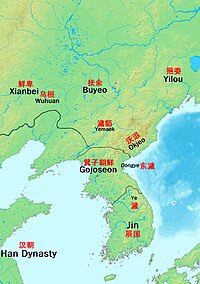Go-Joseon
| History of korea |
|---|
| Prehistoric Korea |
|
| Antiquity |
| Proto-three realms |
|
| Time of the Three Kingdoms |
| Northern and Southern states |
|
| Later three realms |
|
| States of imperial unity |
|
| Colonial times |
|
| Division of Korea |
|
| Korean spelling | |
|---|---|
| Korean alphabet : | 고조선 |
| Hanja : | 古 朝鮮 |
| Revised Romanization : | Go-Joseon |
| McCune-Reischauer : | Ko-Josŏn |
Go-Joseon ( German old Joseon , in contrast to the later Joseon ) is considered in Korean historiography as the first kingdom on the Korean Peninsula . It was possibly founded in the Bronze Age and existed until 108 BC. The chronology is controversial because the archaeological finds cannot easily be reconciled with the dates of written sources.
founding
Legend has it that Go-Joseon was founded in 2333 BC. Founded by the demigod Dangun Wanggeom . This year, widely recognized in Korea as the founding year, refers to a statement in the Dongguk Tonggam . Other ancient scriptures differ from this, but most sources give a date within the reign of the Chinese Emperor Yao (around 2300 BC). It is believed that the Dangun myth refers to a union of different tribes and clans. The written fixation of the reigns of Dangun and his alleged descendants, which are said to have established a one to two thousand year dynasty (depending on whether the fictional dynasty of Giya is taken into account or not), took place only from the early 15th century AD, and later.
Unearthed bronze weapons and mirrors bear witness to the colonization of Korea at this time, but do not allow any conclusions to be drawn about a local state or its ruler. Around 2000 BC A new pottery technique developed.
However, other literature also mentions a founding period from around 500 to 400 BC. BC, which coincides with the first mentions of the area in Chinese sources; In the 4th century BC, educated circles in China were aware of the existence of a state in Korea; according to the Chinese perspective "barbarians".
Giya-Joseon (approx. 1126–194 BC)
Gija , according to Chinese sources Jizi , the uncle of the last emperor of the Shang dynasty , introduced the Chinese culture to Go-Joseon . Like Dangun, a dynasty was ascribed to him in the Joseon period, which lasted about a thousand years until the 2nd century BC. Should have persisted. Apart from literary fiction, there is also no archaeological evidence for the Giya dynasty and the expansion of their empire. The last king who is said to have been driven out by Wiman was therefore called Jun .
During the Warring States Period (476–221 BC) Go-Joseon came into conflict with the Zhou dynasty several times and war refugees from China pushed east. During this time the iron processing technique spread to Korea. At the same time, the Jin Empire emerged in the south of the Korean Peninsula , about which little is known.
Wiman-Joseon (194-108 BC)
Wiman-Joseon formed the last phase of the old Korean "proto-state". According to Chinese sources, Wei Man ( Kor. Wiman ), a general of the Yan Empire who rebelled against the Chinese Han emperor, fled to Go-Joseon with 1,000 followers and took over there around 194 BC. The rule. He declared Wanggeom-seong (presumably near what is now Pyongyang ) the capital. After that, the kingdom of Go-Joseon, often referred to as "Wiman-Joseon", flourished. Politically, he expanded Go-Joseon's influence by occupying the surrounding areas; economically, he controlled trade between the Chinese Han dynasty, with which he initially came to terms, and the north-eastern regions.
With the rise of Go-Joseon, the Han dynasty was increasingly threatened, and in 109 BC. BC Emperor Wu launched an attack on Go-Joseon. After a year, Chinese troops took the capital Wanggeomseong against Wei Man's grandson Ugu (or Yougu ), which meant the end for Go-Joseon and spread the population over the entire peninsula. Wu had four colonies dependent on China set up in the area of the former Go-Joseon, which are called "command offices ": in addition to the most important Lelang ( Chinese 樂 浪 ; Nangnang) these were Xuantu ( 玄 菟 ; Hyeondo), Zhenfan ( 真 番 ; Jinbeon) and Lintun ( 臨 屯 ; Imdun).
Soon numerous small empires formed alongside the Chinese colonies. The smaller three colonies quickly fell back to the Southeast Confederation of Samhan . In 313 AD Lelang was finally defeated by the northern kingdom of Goguryeo .
See also
Individual evidence
- ↑ a b c The Brockhaus in Text and Image 2003 [SW], electronic edition for Office Library, Bibliographisches Institut & FA Brockhaus, 2003; Article: "Korea until AD 668: State formation in the land of the morning calm"
literature
- Carter J. Eckert, Ki-baik Lee, Young Ick Lew, Michael Robinson, Edward W. Wagner: Korea Old and New. A history. Ilchokak, Seoul 1990, ISBN 0-9627713-0-9 .
- Marion Eggert, Jörg Plassen: Small history of Korea (= Beck'sche series. 1666). Beck, Munich 2005, ISBN 3-406-52841-4 .
- Harold Hakwon Sunoo: A History of Korea. Ancient time to 1945. Xlibris Corporation, sl 2006, ISBN 1-4257-0948-6
